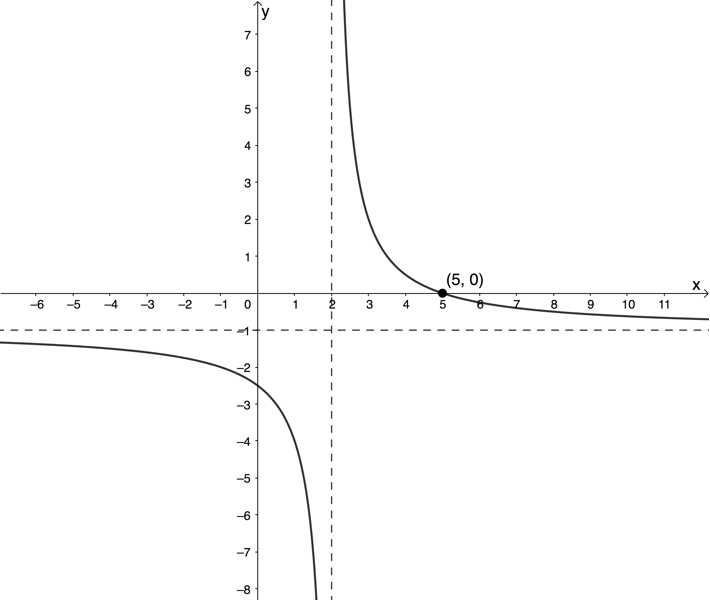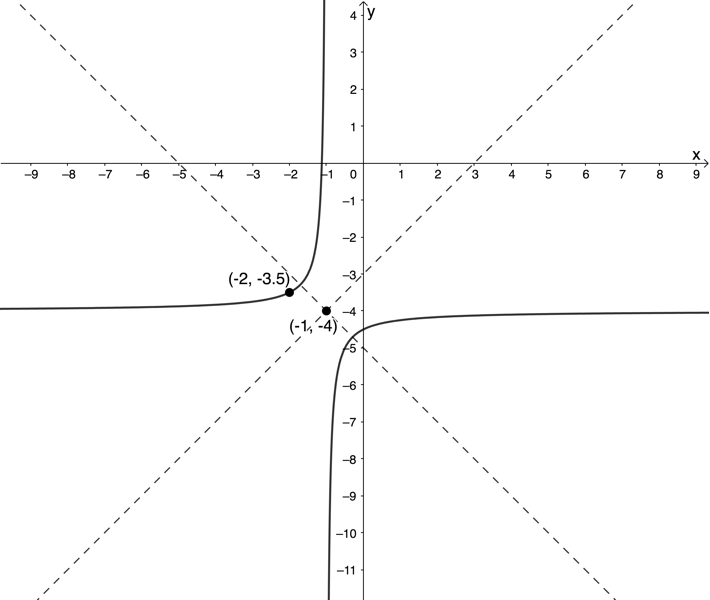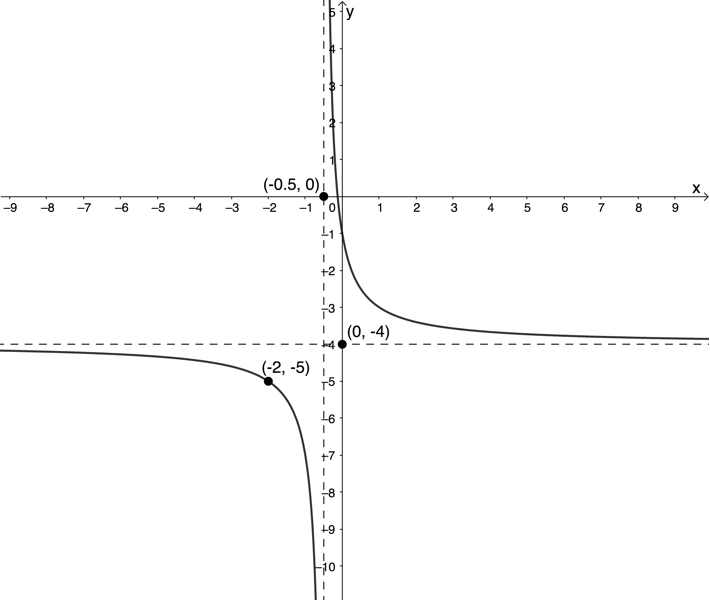Functions and algebra: Use a variety of techniques to sketch and interpret information from graphs of functions
Unit 4: Find the equation of hyperbolic functions
Dylan Busa
Unit outcomes
By the end of this unit you will be able to:
- Find the equation of a hyperbola in the form [latex]\scriptsize y=\displaystyle \frac{a}{{x+p}}+q[/latex].
What you should know
Before you start this unit, make sure you can:
- Solve linear simultaneous equations. Refer to level 2 subject outcome 2.3 unit 4 if you need assistance.
- Determine the domain and range of hyperbolic functions of the form [latex]\scriptsize y=\displaystyle \frac{a}{{x+p}}+q[/latex]. Refer to unit 3 in this subject outcome if you need assistance.
- Find the asymptotes of hyperbolic functions of the form [latex]\scriptsize y=\displaystyle \frac{a}{{x+p}}+q[/latex]. Refer to unit 3 in this subject outcome if you need assistance.
- Find the axes of symmetry of hyperbolic functions of the form [latex]\scriptsize y=\displaystyle \frac{a}{{x+p}}+q[/latex]. Refer to unit 3 in this subject outcome if you need assistance.
- Find the intercepts with the axes of hyperbolic functions of the form [latex]\scriptsize y=\displaystyle \frac{a}{{x+p}}+q[/latex]. Refer to unit 3 in this subject outcome if you need assistance.
Introduction
In the previous unit we learnt how to determine various characteristics of hyperbolic functions of the form [latex]\scriptsize y=\displaystyle \frac{a}{{x+p}}+q[/latex] in order to sketch their graphs, called hyperbolae.
These characteristics of a hyperbola include:
- the domain and range
- the asymptotes
- the axes of symmetry
- and the intercepts with the axes.
In this unit, we will see how we can use these characteristics from a hyperbola to determine the equation of the hyperbolic function. The best way to learn how to do this, is to work through a number of different examples.
Finding the equation of a hyperbola
To find the equation of a hyperbolic function of the form [latex]\scriptsize y=\displaystyle \frac{a}{{x+p}}+q[/latex] from its graph, we need to find the values of [latex]\scriptsize a[/latex], [latex]\scriptsize p[/latex] and [latex]\scriptsize q[/latex].
We can always determine whether [latex]\scriptsize a \gt 0[/latex] or [latex]\scriptsize a \lt 0[/latex] by looking at which quadrants the graph lies in. We can determine the values of [latex]\scriptsize p[/latex] and [latex]\scriptsize q[/latex] by looking at the:
- asymptotes
- point where the axes of symmetry intersect.
Because we have three unknowns to find, we require three pieces of information.
Example 4.1
The graph below is a hyperbola of the form [latex]\scriptsize y=\displaystyle \frac{a}{{x+p}}+q[/latex]. Determine the equation of the function.

Solution
We have been given three pieces of information. We know the asymptotes and we have a point on the graph which happens to be the x-intercept.
We know that the asymptotes of a hyperbola are given by the lines [latex]\scriptsize x=-p[/latex] and [latex]\scriptsize y=q[/latex]. The asymptotes are the lines [latex]\scriptsize x=2[/latex] and [latex]\scriptsize y=-1[/latex]. Therefore, [latex]\scriptsize p=-2[/latex] and [latex]\scriptsize q=-1[/latex].
The equation of the hyperbola is [latex]\scriptsize y=\displaystyle \frac{a}{{x-2}}-1[/latex]. We can substitute the point [latex]\scriptsize (5,0)[/latex] into this equation to find the value of [latex]\scriptsize a[/latex].
[latex]\scriptsize \begin{align*}0 & =\displaystyle \frac{a}{{5-2}}-1\\\therefore \displaystyle \frac{a}{3} & =1\\\therefore a & =3\end{align*}[/latex]
We know that [latex]\scriptsize a \gt 0[/latex] because the graph lies in the first and third quadrants.
The equation of the function is [latex]\scriptsize y=\displaystyle \frac{3}{{x-2}}-1[/latex].
Example 4.2
The graph below is a hyperbola of the form [latex]\scriptsize y=\displaystyle \frac{a}{{x+p}}+q[/latex]. Determine the equation of the function if the axes of symmetry intersect at the point [latex]\scriptsize (-1,-4)[/latex] and the point [latex]\scriptsize (-2,-3.5)[/latex] lies on the graph.

Solution
Again, we have been given three pieces of information. We know the equations of the axes of symmetry (not directly but we could easily work them out using the point of intersection) and we have a point on the graph.
We know that the point where the axes of symmetry meet is the point [latex]\scriptsize (-p,q)[/latex]. Therefore, [latex]\scriptsize p=1[/latex] and [latex]\scriptsize q=-4[/latex].
The equation of the hyperbola is [latex]\scriptsize y=\displaystyle \frac{a}{{x+1}}-4[/latex]. We can substitute the point [latex]\scriptsize (-2,-3.5)[/latex] into the equation to find the value of [latex]\scriptsize a[/latex].
[latex]\scriptsize \begin{align*}-\displaystyle \frac{7}{2} & =\displaystyle \frac{a}{{(-2)+1}}-4\\\therefore a & =-4+\displaystyle \frac{7}{2}\\ &=-\displaystyle \frac{1}{2}\end{align*}[/latex]
We know that [latex]\scriptsize a \lt 0[/latex] because the graph lies in the second and fourth quadrants.
The equation of the function is [latex]\scriptsize y=-\displaystyle \frac{{\displaystyle \frac{1}{2}}}{{x+1}}-4[/latex].
Example 4.3
A hyperbola of the form [latex]\scriptsize y=\displaystyle \frac{a}{{x+p}}+q[/latex] has axes of symmetry of [latex]\scriptsize y=x-1[/latex] and [latex]\scriptsize y=-x+5[/latex]. It has a y-intercept of [latex]\scriptsize (0,\displaystyle \frac{8}{3})[/latex]. Find the equation of the function.
Solution
We have been given three pieces of information – the equations of the axes of symmetry and a point that lies on the graph.
We cannot determine the values of [latex]\scriptsize p[/latex] or [latex]\scriptsize q[/latex] directly from the axes of symmetry. We need to determine their point of intersection by solving these two linear equations simultaneously.
[latex]\scriptsize y=x-1[/latex] (1)
[latex]\scriptsize y=-x+5[/latex] (2)
Substitute (2) into (1):
[latex]\scriptsize \begin{align*}-x+5 & =x-1\\\therefore 2x & =6\\\therefore x & =3\end{align*}[/latex]
Substitute [latex]\scriptsize x=3[/latex] into (2):
[latex]\scriptsize \begin{align*}y&=-3+5\\&=2\end{align*}[/latex]
The point of intersection is [latex]\scriptsize (3,2)[/latex]. The point of intersection of the axes of symmetry is the point [latex]\scriptsize (-p,q)[/latex]. Therefore, [latex]\scriptsize p=-3[/latex] and [latex]\scriptsize q=2[/latex].
The equation of the hyperbola is [latex]\scriptsize y=\displaystyle \frac{a}{{x-3}}+2[/latex]. We can substitute the point [latex]\scriptsize (0,\displaystyle \frac{8}{3})[/latex] into the equation to find the value of [latex]\scriptsize a[/latex].
[latex]\scriptsize \begin{align*}\displaystyle \frac{8}{3} & =\displaystyle \frac{a}{{0-3}}+2\\\therefore \displaystyle \frac{a}{3}&=2-\displaystyle \frac{8}{3}=-\displaystyle \frac{2}{3}\\\therefore a&=-2\end{align*}[/latex]
The equation of the function is [latex]\scriptsize y=-\displaystyle \frac{2}{{x-3}}+2[/latex].
Exercise 4.1
- The axes of symmetry of a hyperbola [latex]\scriptsize f(x)[/latex] intersect at the point [latex]\scriptsize (-3,2)[/latex] and the graph has an x-intercept of [latex]\scriptsize (-2,0)[/latex]. Determine the equation of [latex]\scriptsize f(x)[/latex].
- [latex]\scriptsize g(x)=\displaystyle \frac{a}{{x+p}}+q[/latex] has a domain of [latex]\scriptsize \{x|x\in \mathbb{R},x\ne -1\}\text{ }[/latex] and a range of [latex]\scriptsize \{g(x)|g(x)\in \mathbb{R},g(x)\ne -2\}\text{ }[/latex]. If [latex]\scriptsize g(-2)=-6[/latex], determine the equation of [latex]\scriptsize g(x)[/latex].
The full solutions are at the end of the unit.
Summary
In this unit you have learnt the following:
- How to find the equation of a hyperbola of the form [latex]\scriptsize y=\displaystyle \frac{a}{{x+p}}+q[/latex].
Unit 4: Assessment
Suggested time to complete: 20 minutes
- The graph shows the graph of a hyperbolic function of the form [latex]\scriptsize y=\displaystyle \frac{a}{{x+p}}+q[/latex]. Find the equation of the function.

- The axes of symmetry of a hyperbola [latex]\scriptsize s(x)=\displaystyle \frac{a}{{x+p}}+q[/latex] are [latex]\scriptsize y=x+2[/latex] and [latex]\scriptsize y=-x+6[/latex]. If [latex]\scriptsize s(0)=6[/latex], determine the equation of [latex]\scriptsize s(x)[/latex].
The full solutions are at the end of the unit.
Unit 4: Solutions
Exercise 4.1
- The axes of symmetry of [latex]\scriptsize f(x)[/latex] intersect at [latex]\scriptsize (-3,2)[/latex]. Therefore, [latex]\scriptsize p=3[/latex] and [latex]\scriptsize q=2[/latex].
[latex]\scriptsize f(x)=\displaystyle \frac{a}{{x+3}}+2[/latex]. Substitute in [latex]\scriptsize (-2,0)[/latex].
[latex]\scriptsize \begin{align*}0&=\displaystyle \frac{a}{{(-2)+3}}+2\\\therefore a&=-2\end{align*}[/latex]
[latex]\scriptsize f(x)=-\displaystyle \frac{2}{{x+3}}+2[/latex] - Domain of [latex]\scriptsize g(x)[/latex] [latex]\scriptsize \{x|x\in \mathbb{R},x\ne -1\}\text{ }[/latex]. Therefore, the vertical asymptote is the line [latex]\scriptsize x=-1[/latex]. Therefore, [latex]\scriptsize p=1[/latex].
Range of [latex]\scriptsize g(x)[/latex] is [latex]\scriptsize \{g(x)|g(x)\in \mathbb{R},g(x)\ne -2\}\text{ }[/latex]. Therefore, the horizontal asymptote is [latex]\scriptsize y=-2[/latex]. Therefore [latex]\scriptsize q=-2[/latex].
[latex]\scriptsize g(x)=\displaystyle \frac{a}{{x+1}}-2[/latex]
[latex]\scriptsize g(-2)=-6[/latex]. Therefore, the point [latex]\scriptsize (-2,-6)[/latex] lies on the graph. Substitute this into [latex]\scriptsize g(x)[/latex].
[latex]\scriptsize \begin{align*}-6 & =\displaystyle \frac{a}{{(-2)+1}}-2\\\therefore a & =4\end{align*}[/latex]
[latex]\scriptsize g(x)=\displaystyle \frac{4}{{x+1}}-2[/latex]
Unit 4: Assessment
- The vertical asymptote is given as [latex]\scriptsize x=-\displaystyle \frac{1}{2}[/latex]. Therefore, [latex]\scriptsize p=\displaystyle \frac{1}{2}[/latex].
The horizontal asymptote is given as [latex]\scriptsize \displaystyle y=-4[/latex]. Therefore [latex]\scriptsize q=-4[/latex].
[latex]\scriptsize y=\displaystyle \frac{a}{{x+\displaystyle \frac{1}{2}}}-4[/latex]. Substitute in the point [latex]\scriptsize (-2,-5)[/latex].
[latex]\scriptsize \begin{align*}-5 & =\displaystyle \frac{a}{{(-2)+\displaystyle \frac{1}{2}}}-4\\\therefore \displaystyle \frac{a}{{\displaystyle \frac{3}{2}}} & =1\\\therefore a & =\displaystyle \frac{3}{2}\end{align*}[/latex]
[latex]\scriptsize y=\displaystyle \frac{{\displaystyle \frac{3}{2}}}{{x+\displaystyle \frac{1}{2}}}-4[/latex] - To determine the point [latex]\scriptsize (-p,q)[/latex], we need to find the point where the axes of symmetry intersect.
[latex]\scriptsize y=x+2[/latex] (1)
[latex]\scriptsize y=-x+6[/latex] (2)
Substitute (2) into (1):
[latex]\scriptsize \begin{align*}-x+6 & =x+2\\\therefore -2x & =-4\\\therefore x & =2\end{align*}[/latex]
Substitute [latex]\scriptsize 2[/latex] into (2):
[latex]\scriptsize \begin{align*}y&=-2+6\\&=4\end{align*}[/latex]
[latex]\scriptsize (-p,q)=(2,4)[/latex]. Therefore, [latex]\scriptsize p=-2[/latex] and [latex]\scriptsize \displaystyle q=4[/latex]
[latex]\scriptsize s(x)=\displaystyle \frac{a}{{x-2}}+4[/latex]
But [latex]\scriptsize s(0)=6[/latex]. Therefore, substitute in [latex]\scriptsize (0,6)[/latex].
[latex]\scriptsize \begin{align*}6&=\displaystyle \frac{a}{{0-2}}+4\\\therefore \displaystyle \frac{a}{2}&=-2\\\therefore a&=-4\end{align*}[/latex]
[latex]\scriptsize s(x)=-\displaystyle \frac{4}{{x-2}}+4[/latex]
Media Attributions
- example4.1 © Geogebra is licensed under a CC BY-SA (Attribution ShareAlike) license
- example4.2 © Geogebra is licensed under a CC BY-SA (Attribution ShareAlike) license
- assessmentQ1 © Geogebra is licensed under a CC BY-SA (Attribution ShareAlike) license
